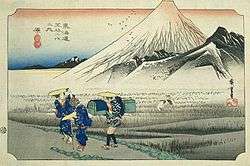浮世絵
Japanese
| Kanji in this term | ||
|---|---|---|
| 浮 | 世 | 絵 |
| う(き) Grade: S |
よ Grade: 3 |
え Grade: 2 |
| kun’yomi | ||
Etymology
Compound of 浮世 (ukiyo, “the floating world, the pleasure quarters”, in reference to the first main subject area) + 絵 (e, “picture, illustration”).[1][2][3][4]
Pronunciation
Noun
浮世絵 (shinjitai kanji, kyūjitai kanji 浮世繪, hiragana うきよえ, rōmaji ukiyoe, historical hiragana うきよゑ)
- ukiyo-e, Japanese paintings and woodblock prints of the Edo period
- erotica
- (The addition of quotations indicative of this usage is being sought):
References
- 1988, 国語大辞典(新装版) (Kokugo Dai Jiten, Revised Edition) (in Japanese), Tōkyō: Shogakukan
- 1995, 大辞泉 (Daijisen) (in Japanese), Tōkyō: Shogakukan, →ISBN
- 2006, 大辞林 (Daijirin), Third Edition (in Japanese), Tōkyō: Sanseidō, →ISBN
- 1997, 新明解国語辞典 (Shin Meikai Kokugo Jiten), Fifth Edition (in Japanese), Tōkyō: Sanseidō, →ISBN
- 1998, NHK日本語発音アクセント辞典 (NHK Japanese Pronunciation Accent Dictionary) (in Japanese), Tōkyō: NHK, →ISBN
This article is issued from
Wiktionary.
The text is licensed under Creative
Commons - Attribution - Sharealike.
Additional terms may apply for the media files.
